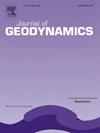Late Carboniferous-Early Permian geodynamic evolution of NW Iran: Zircon U-Pb ages, Hf isotopes, and whole rock geochemistry of Salmas amphibolites
IF 2.1
3区 地球科学
Q2 GEOCHEMISTRY & GEOPHYSICS
引用次数: 0
Abstract
We present new geochronological, petrological, and geochemical data from the amphibolites of the Salmas metamorphic complex in NW Iran. This region is where the Sanandaj-Sirjan magmatic-metamorphic zone, the Urmia-Dokhtar magmatic arc, and the Eastern Anatolian Plateau converge, creating a complex geodynamic context. The amphibolites alternate with gneisses and metamorphosed limestone layers and appear as enclaves of varying sizes within the gneisses. Fine- to medium-grained amphibole and plagioclase, exhibiting a granoblastic texture, are the dominant minerals, indicating basaltic and diabasic protoliths. The amphiboles show simple foliation along lineation, which is occasionally folded. These amphibolites are overlain by Permian to Jurassic sedimentary rocks and, in some places, by Miocene sediments with angular unconformity. Based on whole-rock geochemistry, the amphibolites have relatively high TiO2 (1.23–2.62 wt%) and low MnO (0.18–0.21 wt%) contents, classifying them as ortho-amphibolites. The parental magma was sub-alkaline basaltic with tholeiitic affinities, formed in a within-plate tectonic setting. This is characterized by enrichment in LREE relative to HREE, a lack of Nb, Ta, and Ti anomalies, and the presence of negative Eu and positive Ba anomalies. The ɛHf(t) and 176Hf/177Hf ratios of dated zircons suggest a depleted mantle to lower crust origin for the parental magma of the amphibolites. U-Pb dating of zircon grains yields a mean age of 304.8 Ma, corresponding to Late Carboniferous-Early Permian magmatism related to the opening of the Neotethys Ocean. The thermal effects of Late Cretaceous to Early Cenozoic subduction-related magmatic events are recorded by overgrown metamorphic zircon around original magmatic grains.
伊朗西北部晚石炭世—早二叠世地球动力学演化:锆石U-Pb年龄、Hf同位素及Salmas角闪岩全岩地球化学
我们提出了伊朗西北部萨尔马斯变质杂岩的角闪岩的新的年代学,岩石学和地球化学数据。该地区是Sanandaj-Sirjan岩浆变质带、ur米亚- dokhtar岩浆弧和东安纳托利亚高原交汇的地方,形成了复杂的地球动力学背景。角闪岩与片麻岩和变质灰岩层交替存在,在片麻岩中形成大小不等的飞地。细粒至中粒角闪石和斜长石是主要矿物,呈花岗母粒结构,指示玄武岩和辉绿岩原岩。角闪石沿线理呈简单的片理,偶有褶皱。这些角闪岩被二叠纪至侏罗纪沉积岩覆盖,在某些地方,还被角不整合的中新世沉积岩覆盖。全岩地球化学特征表明,该角闪岩TiO2含量较高(1.23 ~ 2.62 wt%), MnO含量较低(0.18 ~ 0.21 wt%),属于正长角闪岩。母岩浆为亚碱性玄武岩,具有拉斑岩的亲缘关系,形成于板块内构造环境。其特征是LREE相对于HREE富集,缺乏Nb、Ta和Ti异常,存在负Eu和正Ba异常。年代锆石的Hf(t)比值和176Hf/177Hf比值表明角闪岩母岩浆的成因为幔-下地壳枯竭。锆石U-Pb测年结果显示,锆石的平均年龄为304.8 Ma,对应于晚石炭世-早二叠世岩浆活动,与新特提斯洋的打开有关。晚白垩世至早新生代与俯冲有关的岩浆事件的热效应被原始岩浆颗粒周围生长的变质锆石所记录。
本文章由计算机程序翻译,如有差异,请以英文原文为准。
求助全文
约1分钟内获得全文
求助全文
来源期刊

Journal of Geodynamics
地学-地球化学与地球物理
CiteScore
4.60
自引率
0.00%
发文量
21
审稿时长
6-12 weeks
期刊介绍:
The Journal of Geodynamics is an international and interdisciplinary forum for the publication of results and discussions of solid earth research in geodetic, geophysical, geological and geochemical geodynamics, with special emphasis on the large scale processes involved.
 求助内容:
求助内容: 应助结果提醒方式:
应助结果提醒方式:


